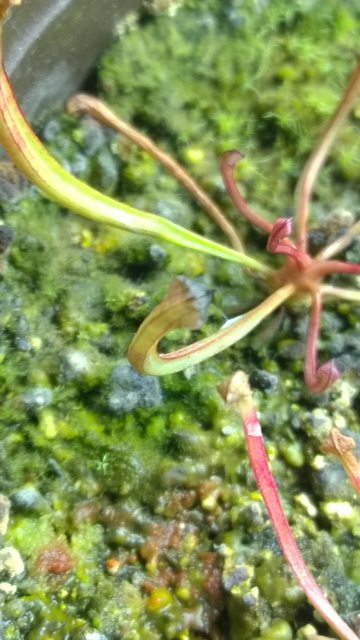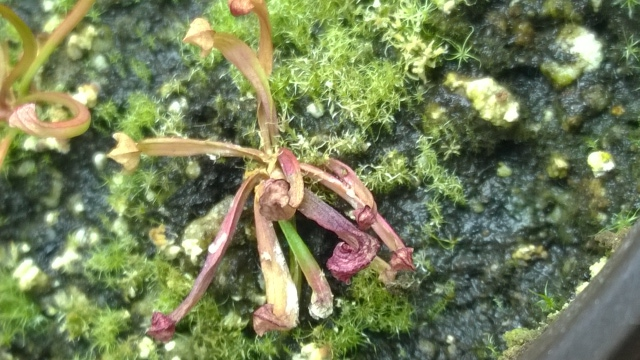Question leuc
leuc
 Venosa
Venosa
QUESTION: I have year old seedlings of flava, venosa, leucophylla. They are starting to blacken at their hoods. Both old and new growth. They are a indoors, foot away from a 65000K 20,000 lumen light, sit in a tray of water with mosquito dunk, distilled water, 50-70% humidity, about 65 degrees, no fertilizer, 60/40 peat perlite. There is green slime on the soil, as well as white fluffy mold and some black spots on the white mold forming raised lumps. They receive 11 hours of sunlight. My drosera nearby are red and dewy. The capes bloomed too. I did spray a while ago with this imunichlorid stuff for fungus gnats that you recommended, and some stuck to the plants. Do you know what I can do? I can't transplant due to the cold outside.
ANSWER: Hi David,
What this looks like is that you've gotten some peat moss that has a high mineral content, and you are just now starting to see damage from it. The white tufts that look like mold are really mineral deposits. This is an increasingly (and frustratingly) more and more common problem with commercial peat moss sold in garden centers.
Here's what you can do. The purp. venosa seedling is already gone, so not much you can do there. The Leuco isn't so transplant it to some fresh media. If you have other plants that are in the same media, and you're seeing those little deposits, best transplant those too if they've been in the media for over 6 months. Different plants respond differently depending on their tolerance for extra minerals in their soil. Plants like Mexican butterworts and Dewy Pines wouldn't care in the least. Venus flytraps are the most sensitive. Sundews are often species by species. Temperate varieties are often fairly sensitive to minerals. Sarracenia will tolerate minerals for a long time, but the start showing slow damage, and seedlings are going to be more sensitive.
You can still use regular commercial peat, but what you need to do is soak and drain it before mixing it with perlite. Just fill a bucket and put enough low mineral water over the peat to make a slurry with a little extra water. Give it a couple days to saturate and settle, then drain off and squeeze off as much water as possible. This will remove much of the minerals and make it better to use.
We had to switch to a coarse grower's grade peat available through a horticultural supply company. It's lighter in color, gives off very little minerals into water, and lasts much longer. It also costs more. That is what we use now in all our peat based soil mixes sold on our website. I know this is similar for many other cp nurseries.
Here's a helpful link on rinsing peat: http://www.growsundews.com/rinsing_peat_and_sand_for_carnivorous_plants.html
Good Growing!
Jeff Dallas
Sarracenia Northwest
http://www.growcarnivorousplants.com
---------- FOLLOW-UP ----------
QUESTION: I am transplanting all my seedlings now. Would it help to run water through the top every now and again to prevent this?
AnswerHi David,
Yes. If you do regular top-watering, and flush quite a bit of water through the media it really helps. Empty your water trays periodically too. In the Pacific Northwest we tend to have very rainy winters, so plants outside have never been a concern for us with this mineral issue. We started seeing the problem more in greenhouse plants that were not top-watered very often.
Good Growing!
Jeff Dallas
Sarracenia Northwest
http://www.growcarnivorousplants.com







